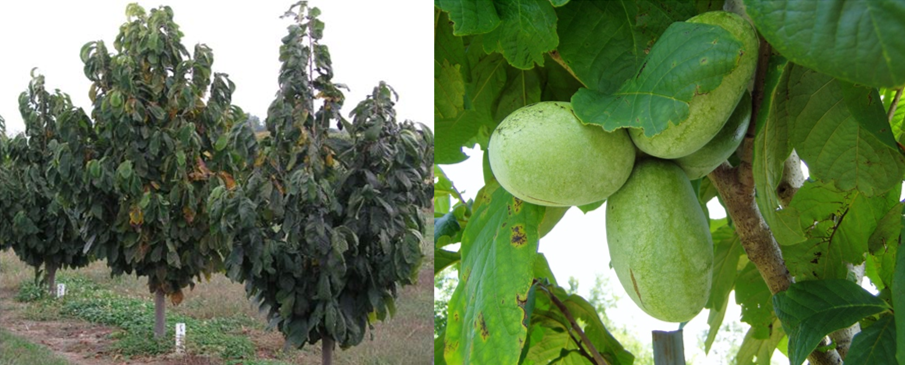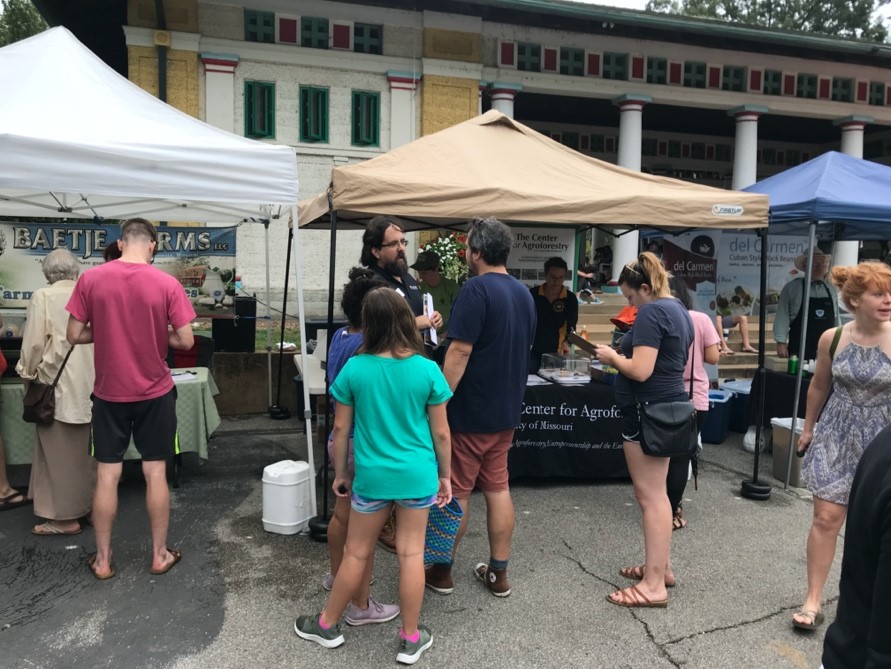Pawpaw (Asimina triloba (L.) Dunal) is the largest edible tree fruit native to the United States. Though consumption of pawpaws is not widespread in the modern-day US, pawpaws have been consumed by Native Americans for millennia. Pawpaw fruits have a very sweet tropical flavor and tastes as a mixture of banana, mango, and pineapple (Brannan et al. 2012). The fruit is nutritious and it supplies protein, numerous minerals, and vitamin C (Kobayashi et al. 2008). Pawpaws can be consumed raw or be processed into pulp and used to make food products such as beer, ice cream, yogurt, beverages, and baked goods.
 Figure 1. Pawpaw trees at State Fruit Experiment Station, Mountain Grove, MO (Left) and pawpaw fruits at Southwest Research Center, Mt Vernon, MO (Right). Credits: Patrick Byers and Andrew Thomas
Figure 1. Pawpaw trees at State Fruit Experiment Station, Mountain Grove, MO (Left) and pawpaw fruits at Southwest Research Center, Mt Vernon, MO (Right). Credits: Patrick Byers and Andrew Thomas
Over the past 5 years, the Center for Agroforestry at University of Missouri has been conducting research examining the current US pawpaw market. Pawpaw producers in the US were surveyed regarding their pawpaw businesses, perceived pawpaw production barriers, and their attitudes to the current and future supply and demand of pawpaws and its products. Regional consumer surveys at four farmers markets in Missouri (Columbia Farmers Market, Tower Grove Farmers Market, City Market in Kansas City, and Farmers Market of the Ozarks) and a national consumer survey were conducted to examine consumer familiarity with pawpaws and their purchasing prefereneces for pawpaws.
Producers
Producers in the US pawpaw industry include: tree growers, fruit growers, fruit pickers, value-added producers, distributors, retailers, and wholesalers. Pawpaw producers are dominated by small-scale or part-time producers. Most pawpaw producers earn sales incomes less than $5,000 per year, and only 15% of the surveyed producers operate their businesses as full-time occupations.
Production and marketing barriers
Producers face several production and marketing barriers. When asked to identify these barriers, producers most frequently mentioned their lack of growing and processing knowledge and skills. Additionally, producers mentioned the unstable supply of some pawpaw products. For instance, high-quality grafted trees may be difficult to find. Lasltly, pawpaws have a short shelf life, which presents some difficulties in preserving and marketing them.
Consumers
US consumers are not very familiar with pawpaws. Survey results indicated that only a quarter of the US consumers had heard about pawpaws, and 19% had eaten pawpaws prior to taking our survey. Fourteen percent of US conumers had purchased fresh pawpaws. However, when consumers had purchased or consumed pawpaws, opinions of the fruits were positive. The majority of pawpaw consumers reported that they liked to eat fresh pawpaws and enjoyed its texture and flavor. Consumers also showed a strong interest in purchasing fresh pawpaws in the future.
Selling fresh pawpaws at Farmers markets has proven to be an effective strategy. More than half of the farmers market consumers had heard about pawpaws. The farmers market is the top place where consumers purchase pawpaws, followed by grocery stores. Approximately 30% of the farmers market consumers had eaten pawpaws before.
 Figure 2. Consumer survey data collection at Tower Grove Farmers Market, St. Louis, MO
Figure 2. Consumer survey data collection at Tower Grove Farmers Market, St. Louis, MO
Market Outlets and Prices
Growers sell fresh pawpaws and value added products through different outlets including: farmers market, restaurants/chefs, health and natural food store, grocery store, online, and others. Current prices for fresh pawpaws, frozen pulp, jams, seeds, seedlings, and grafted cultivars are provided in Table 1.
Table 1. Reported prices for pawpaws and its products based on our pawpaw producer survey
|
Product |
Price |
|
Fresh Pawpaws |
$2 to $15 per pound |
|
Frozen Pulp |
$8 per pound |
|
Pawpaw Jam |
$8 per pound |
|
Seeds |
$0.2 to $0.5 per seed |
|
Tree Seedlings |
$8 to $35 per tree |
|
Grafted Trees |
$35 to $50 per cultivar |
Future market
We are optimistic about future supply and demand in the pawpaw market. A majority of pawpaw porucers predicted that pawpaw supply will increase in the next five years. Additionally, consumer demand for fresh pawpaws may increase in the future, since consumers enjoyed eating fresh pawpaws and expressed desire to purchase more pawpaws in the future.
The following marketing strategies may aide pawapaw producers:
- Producers benefit from selling their products at local outlets such as farmers markets.
- Providing information on the health benefits of pawpaws when selling pawpaws and pawpaw products can increase consumer purchasing preferences.
- Labelling organic and pesticide-free production processes also can potentially increase consumer demand for fresh pawpaws.
References:
Brannan, R.G., Salabak, D.E. and Holben, D.H., 2012. Sensory analysis of pawpaw (Asimina triloba) pulp puree: Consumer appraisal and descriptive lexicon. Journal of Food Research, 1(1), p.179.
Kobayashi, H., Wang, C. and Pomper, K.W., 2008. Phenolic content and antioxidant capacity of pawpaw fruit (Asimina triloba L.) at different ripening stages. HortScience, 43(1), pp.268-270.